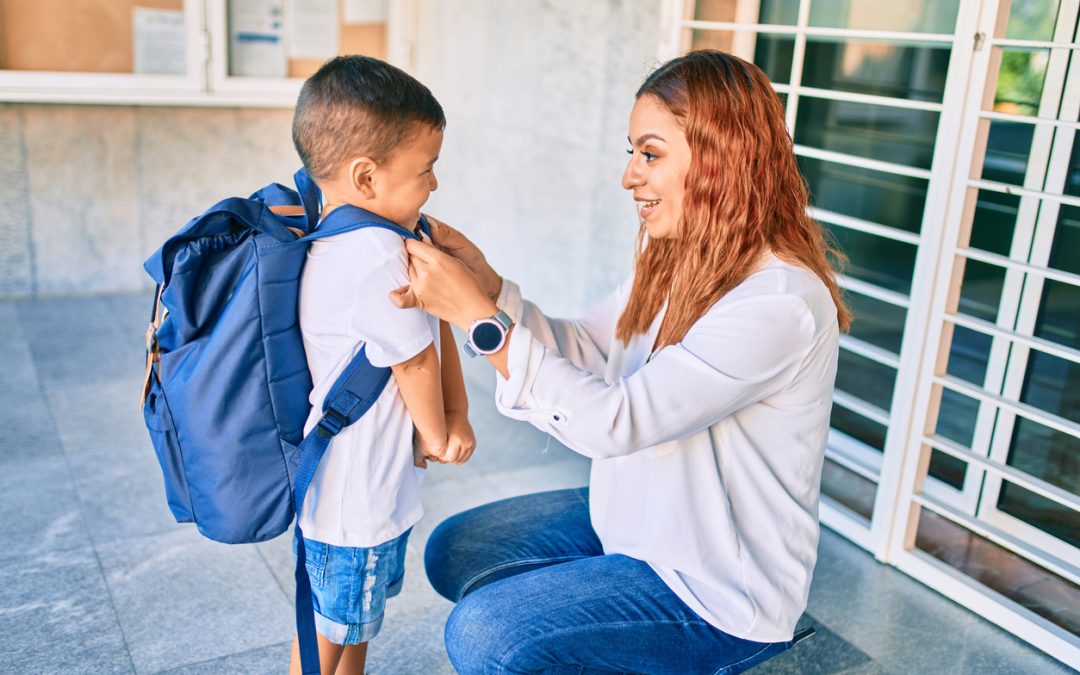When it comes to back-to-school supplies, nothing works harder for your student than their backpack. Picking backpacks for kids (and showing them how to wear one properly) is vital: A backpack that’s the wrong size, packed incorrectly, or too worn can cause pain and discomfort on your kid’s spine, shoulders, and neck, and may cause posture issues down the line.
Below, we’ll go over the key features to look for when choosing backpacks for kids and how to wear a backpack properly to avoid (or reduce) back pain. These tips aren’t just for kids: Adults who regularly use backpacks will find these suggestions helpful, too.
Start Fresh
Backpacks go through a lot—they get toted back and forth between school and home—and sometimes on camping trips, day hikes, and vacation, too. They get slung onto tables, stuffed into cubbies and lockers, and dropped on pavement, grass, and wood chips.
So before you dust off last year’s bag for another go around this school year, check it for tears, ripped seams, or thinning straps.
You should also consider buying a fresh backpack for your student each year to ensure that the bag fits their growing frame and can hold more as their curriculum changes.
Pick the Right Size
How should a backpack fit your student? You’ll want a bag that’s only as wide as their shoulders and sits right at the waist, about two inches above the bum. Backpacks that are too big are not just a tripping hazard, they may throw off a wearer’s center of gravity, causing strain on the neck, shoulders, and spine.
Choose the Proper Straps
Have you ever experienced a pinching sensation in your shoulders when wearing a backpack? That may be the straps digging into your trapezius muscle. Choosing a backpack with wide, padded straps can help ease any discomfort. When picking backpacks for kids, make sure that the straps are adjusted properly so they aren’t digging into their arms. Your kiddo should be able to swing their arms comfortably without the straps slipping.
Look for Extra Straps
Some backpacks come with extra straps at the waist and chest, which can provide more support and more evenly distribute the weight of the bag. Just make sure to adjust the straps so they’re snug but not digging into your child’s skin.
Pack Your Bag Properly
Teaching your student to pack their backpack is one of the best ways to support a healthy spine. That’s because the weight of the backpack can be just as detrimental as the size and fit of the bag.
Start by putting the heaviest items all the way at the back of the bag, closest to the body. You’ll also want to evenly distribute the weight of the bag from side to side––unequal weight on one side or the other may cause a temporary kink in the spine.
Avoid Overloading the Backpack
It can be easy to overstuff a backpack, especially as your student gets older and has heavier textbooks and a laptop or tablet to tote around.
Ideally, a backpack should only carry about 15% of your child’s bodyweight. For example, a 100-pound child shouldn’t carry more than 15 pounds. However, a study conducted in 2017 found that students often carry closer to 22% of their body weight in their backpacks.
Encourage Locker Use
One way to help reduce a backpack’s weight is to encourage students to pack only what they need in their bag and store the rest in their locker or cubby at school. Leaving the books and supplies they won’t be using during a class period in their locker will help reduce the weight they carry around throughout the day.
Use Both Straps
Throwing a bag over one shoulder may look cool, but it can really do a number on your back and shoulders. Instruct your student (and remind yourself) to carry your backpack using both straps.
Can Children Visit the Chiropractor?
If your child is experiencing back pain, it may be time to see a chiropractor. You may have a lot of questions about chiropractic care, especially for young children and teenagers. But seeing a pediatric chiropractor can be just as beneficial for your young children as it is for adults. Chiropractic adjustments for children can:
- Improve sleep
- Support healthy development
- Maintain a healthy immune system and reduce sick days
- Reduce anxiety and stress
Showing your kids how to wear a backpack properly can help keep their body healthy and strong. By choosing a bag that’s the right size, and organizing it properly, your student can focus their attention on their studies and their friends.
Looking for a chiropractor in Washington State?
Sources
NBC News. Back to school: How to choose a backpack that won’t hurt your kid’s back.
https://www.nbcnews.com/select/lifestyle/how-choose-backpack-won-t-hurt-your-kids-back-ncna1047231
Very Well Health. 10 Tips for Preventing Pain from Wearing a Backpack. https://www.verywellhealth.com/backpacks-and-back-pain-296597
Johns Hopkins. Back to School: How to Pick and Wear a Backpack. https://www.hopkinsmedicine.org/news/articles/2023/08/back-to-school-how-to-pick-and-wear-a-backpack
Spine Pro Chiropractic. Pediatric Chiropractic Care: What Parents Need to Know. https://spineprochiropractic.com/pediatric-chiropractic-care-what-parents-need-to-know/

